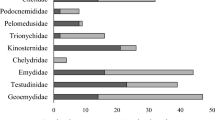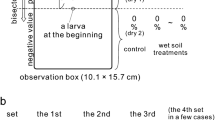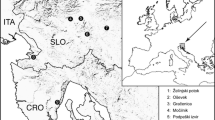Abstract
In order to verify which factors affect habitat selection for aestivating and in the active adult Apostichopus japonicus, animals were tested for their selection of attachment site in an experimental device (1-m pipes) in which the perceived environmental stimuli (light intensity, degree of contact with a hard surface, geotaxis) varied depending on the attachment site. During the aestivating season, the animals showed a strong selection for attachment sites during the daytime and nighttime; they also showed positive stereotaxis (thigmotaxis), negative phototaxis, and negative geotaxis. The results suggest that (1) habitats are not suitable for the aestivating adult A. japonicus unless these three environmental requirements are satisfied.







Similar content being viewed by others
References
Mitsukuri K (1912) Studies on actinopodous Holothurioidea. J Coll Sci Imp Univ Tokyo 29:1–284
Choe S (1963) Biology of the Japanese common sea cucumber Stichopus japonicus Selenka (in Japanese, with English abstract). Kaibundo, Tokyo
Kanno M, Suyama Y, Li Q, Kijima A (2006) Microsatellite analysis of Japanese sea cucumber, Stichopus (Apostichopus) japonicus, supports reproductive isolation in color variants. Mar Biotech 8:672–685
Mitsukuri K (1903) Notes on the habits and life-history of Stichopus japonicus Selenka. Annot Zool Japon 5:1–21
Tokuhisa M (1915) Nanao-wan no Namako ni tsuite. (Studies on sea cucumber in Nanao Bay) (in Japanese). Suisankenkyushi 10:75–79
Miura J (1932) Namako (Sea cucumber) (in Japanese). Suisankenkyushi 17:157–158
Miura J (1934) Namako no kamin ni tsuite (Aestivation of sea cucumber) (in Japanese). Suisankenkyushi 19:321–324
Yamana Y, Hamano T, Goshima S (2008) Individual tracking to specify the aestivation site of adult sea cucumber Apostichopus japonicus on a jetty in Yoshimi Bay, western Yamaguchi Prefecture, Japan. Plankton Benthos Res 3:235–239
Hamano T, Amio M, Hayashi K (1989) Population dynamics of Stichopus japonicus Selenka (Holothuroidea, Echinodermata) in an intertidal zone and on the adjacent subtidal bottom with artificial reefs for Sargassum (in Japanese, with English abstract). Suisanzoshoku 37:179–186
Yamana Y, Hamano T (2006) New size measurement for the Japanese sea cucumber Apostichopus japonicus (Stichopodidae) estimated from the body length and body breadth. Fish Sci 72:585–589
Acknowledgments
We thank Dr. S. Wada and Dr. K. Nakata of Hokkaido University, Dr. T. Handa, and Dr. A. Araki of National Fisheries University for comments on the study. We are grateful to Mr. K. Miki of Tana Marine Biological Laboratory of National Fisheries University for assistance during this study. This study was partly supported by Research Fellowships of the Japan Society for the Promotion of Science (JSPS) for Young Scientists (no. 19-1156).
Author information
Authors and Affiliations
Corresponding author
Rights and permissions
About this article
Cite this article
Yamana, Y., Hamano, T. & Goshima, S. Laboratory observations of habitat selection in aestivating and active adult sea cucumber Apostichopus japonicus . Fish Sci 75, 1097–1102 (2009). https://doi.org/10.1007/s12562-009-0129-6
Received:
Accepted:
Published:
Issue Date:
DOI: https://doi.org/10.1007/s12562-009-0129-6




